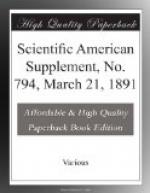The Creusot works alone, of all competitors, were able to fight against the general infatuation. Many comparative experiments had already demonstrated the superiority of the Creusot “all steel” plates over the Cammell plates, but Messrs. Schneider & Go. were not willing to stop here, and finally produced the new nickel steel plate, which is by far superior to their steel plates.
Some comparative trials of these various armor plates have recently been made by a military commission of the United States at the Annapolis proving grounds. Three plates, one a Cammell, the second a steel, and the third a nickel steel (the two last from Creusot), were here submitted to firing, under absolutely identical conditions.
Our engravings show the proving grounds and the details of the arrangements adopted for backing the plates.
Of the three plates, the Cammell was the thickest (11 in.) The steel one was 103/4 in. in thickness, and the nickel steel 101/2 in. The last, therefore, was at a disadvantage with respect to the two others.
The plates were arranged tangentially to an arc of a circle whose center was occupied by the pivot of the gun, and consequently at right angles with the latter. The piece employed was a 6 in. gun, 35 calibers in length. The distance of its muzzle from the plates attacked was 28 ft.
[Illustration]
The charge was 44 lb. of brown prismatic powder. The projectile was a 100 lb. Holtzer shell. Under these circumstances, the initial velocity was 2,074 ft. and the energy at the impact was 9,970,396 ft. lb.
A beginning was made by firing four shots at each plate in the bisectrix of the corners. Then the 6 in. gun was replaced by an 8 in. one, throwing a 209 lb. Firth projectile, with an energy at the impact of 20,795,000 ft. lb.
Each of the plates then received in its center a final blow from this projectile.
Our engraving represents the state of the plates after this last shot.
[Illustration: Armored plate tests at Annapolis]
There is no need of being a great expert in questions of artillery to discover on what side the superiority is found, and to see that the Cammell plate, almost entirely in fragments, is absolutely incapable of protection, while its two competitors are still in a state to resist.
In one of our engravings may be seen, too, the state of the shells after each of the three shots.
[Illustration]
The commission immediately and unanimously classified the three plates in the following order of superiority: (1) Nickel steel; (2) all steel; (3) compound.
This triumph of French industry merits mention so much the more in that it was obtained in a series of experiments made in a foreign country—that is to say, under indisputable conditions of impartiality.-L’Illustration.
* * * * *




